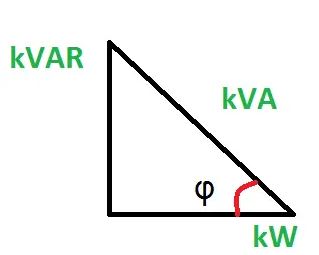In previous newsletters, the focus was placed on the consequences of unbalanced voltages, phase-shift variations, and harmonics disturbances on the power networks and plant. It was hoped that even those in the financial disciplines would be able to “see through the fog” and realize that this would result in enormous Economic Losses. This does not appear to be the case.
Economic Losses
Economic Losses can be categorised as immediate, or short-term losses, and longer-term losses.
Cost of Sales Losses
Short-term losses are “hidden” in the monthly bills and can be found under Cost of Sales in the Income Statement. Most accountants or financial officers simply pays the monthly electricity bills without carefully scrutinizing the account, and when they do, they probably do understand billing items or questioning anything that is listed.
There could be items such as Access Charges, Peak, Standard and/or Off-Peak kVAhr Charges, and Demand Charges that appear on the bill which goes unnoticed. Far more attention is paid to the Peak, Standard and Off-Peak kWh Charges since the amounts are far higher. Well, if the kVAhr Charges are reduced to ZERO, the Peak, Standard and Off-Peak kWh Charges will decrease substantially.
The question is, what does unbalance voltages, phase-shift variations, and harmonics disturbances have to do with this? The answer is, it increases the kVAR values which is referred to as Reactive Power or the Imaginary Component of the power of an alternating current (AC) network. That means it does not make any contribution to the production, but you pay for it though higher energy charges – the units (kVAh) on your bill – plus the kVAhr Charges that large power is charged separately.
So, in the end, both the “ordinary” or residential and large power users – industrial and commercial – all pay for the Apparent Power (kVAh) and only use the Real Power (kW), also referred to as True or Active Power. This is the power that the kettle will consume to heat a certain volume of water, or a machine require to pump a certain volume of liquid, and so forth. That does not change, but the Apparent and Reactive Power components will increase. And so will the amount charged for consumption.
Some large power users – industrial and commercial – are charged extra for the Imaginary Power. See the image below for further explanation of the three components – Real Power (kW), Apparent Power (kVA) and Reactive Power (kVAR).

As said before, large power users – industrial and commercial – are paying for Apparent Power (kVA) while they can only effectively use the Real Power (kW). This is also true for residential single-phase users. In a previous blog posted September 24, 2023, reference was made to an incident that I “accidently” came across when analyzing the measurements which was taken at a substation in Gauteng, South Africa. Both the voltages and currents were severely unbalanced. So, the customers on that 6.6kV feeder are most likely paying around 237.27% more than they ought to due to a kVA to kW ratio of 3.37:1.
However, on top that large power users – industrial and commercial – are charged a monthly fee for an agreed Maximum Demand. Should they exceed the agreed Maximum Demand for a set period during the month, they get charged a penalty fee which is rather substantial. Many large power users are paying far too much for the Maximum Demand without being aware of it. The penalty fee for exceeding the Maximum Demand is most likely a major problem which is as a direct consequence of load-shedding. Read more about how Negative Phase Sequencing can cause severe damage to plant.
Unbalance voltages, phase-shift variations, and harmonics disturbances primarily lead to plant breakdowns. Indirectly, is causes more frequent plant shutdowns and loss of production. Labour cost increases as these shutdowns often requires maintenance crews to work overtime or contract in extra labour to fix the problems. Due to production stoppages and the urgency to restart the production, fixed are often – sort of – temporary.
Economic Losses on the Balance Sheet
As for the longer-term losses, the cost of unbalanced voltages, phase-shift variations, and harmonics disturbances on the power networks and plant can be found in the Balance Sheet, that is if you know where to look. Admittedly, these cost items are not that obvious, and it therefore needs to be explained.
The Economic Losses on the Balance Sheet is perhaps a little more difficult to find. Cables, motors, switchgear, and transformers need to be replaced a lot sooner than usual.
The question is, in this context, what does “usual” mean? There is perhaps not a straightforward quantifiable answer to this question. However, if one subject the cables, motors, switchgear, and transformers constantly to these conditions – unbalance voltages, phase-shift variations, and harmonics disturbances – they simply do not last as long as it is supposed to be. Also read more about how Zero-Sequence voltages and currents can cause cables and transformers, amongst others, to deteriorate faster than "normal".
The refurbishment and replacement cost, which could be found under Fixed Assets on the Balance Sheets, would go through the roof, Uninformed accountants or financial officers would hardly ever notice that. They would believe that it is normal. Only those with a wider understanding of both the engineering and financial aspects of business would notice that business expenses are not what it should be.
Is There a Solution?
Now for the “burning question”, is there a solution to all of this? Yes, most certainly, there is. We can install our Power Quality Monitor to measure an immense number of parameters to determine whether you are getting a “clean power supply” or whether there are unbalance voltages and phase-shift variations, and what the Total Harmonics Disturbance (THD) is. Our instrument record up to the 40th Harmonics. We recommend that it should run for a week.
Once the recorded data is extracted, we will analyze it and help in solving the problems, for an additional fee. Should there be power quality issues emanating from upstream, we will assist in taking it up with the relevant power supply utility companies.
Click here to read the Blogs about this and many more.
Click here to read and book our Load Profiling Consulting Service.
Newsletter
Join the mailing list and receive our latest newsletters by simply filling in your email address below and then click Subscribe.
